Serpentine is California's state rock. Composed of hydrous magnesium iron phyllosilicate, it is typically a dark greenish-gray color, often splotchy or veined, with a waxy texture. It is a relatively soft rock (hardness 2.5 to 4) and a relatively light one (specific gravity 2.2 to 2.9). It has often been used for jewelry, stone carvings, railway ballasts, building materials, and road surfaces. Some serpentine rocks contain asbestos, which has sometimes been used as thermal insulation but can cause health problems if the rock breaks down into tiny particles that are inhaled. Naturally occurring asbestos, when left in the ground undisturbed, is not generally believed to pose a significant health threat.
Serpentine is formed when parts of the ocean floor are pushed to the surface of the land, which has happened in the Smartville ophiolite. Named after the town of Smartsville in Yuba County, this ophiolite passes through much of the northern California foothills, reaching from northwestern Lake Oroville southeast to Cameron Park. In Yuba County, it passes through Browns Valley, Brownsville, Challenge, Dobbins, Frenchtown, Greenville, Loma Rica, Oregon House, Rackerby, the Spenceville State Wildlife Area, and of course the town of Smartsville.
All soil consists largely of broken-down rock, so soil in areas of serpentine rock consists largely of broken-down serpentine rock. Because of the unusual chemical components of serpentine rock, soil in these areas is toxic to many plants. Specifically, soil in the Smartville ophiolite contains high levels of nickel, chromium, and cobalt, low levels of potassium and phosphorus, and a low ratio of calcium to magnesium. As a result, the plants that survive in these areas tend to be native species—often rare and endengered species—that have evolved here over millennia. Areas of serpentine-derived soil can be identified by the fact that they are strips of open shrubland with a few scattered small trees, even when adjacent non-serpentine areas are densely forested. In Yuba County, serpentine-adapted plants can be seen especially in areas on Browns Valley Ridge in northwestern Browns Valley, just northeast of Flanly Hill in Oregon House, between Holman Hill and High Prairie south of Collins Lake, on Ure Mountain southeast of Collins Lake, in northern and eastern Rackerby, just north of Chitterden Ridge near Rackerby, just northwest of Ruff Hill in Brownsville, just south of Mount Hope near Challenge, and surrounding Pike County Peak near Greenville.
People who try to plant conventional garden plants in serpentine areas such as the Smartville ophiolite will be very frustrated, because most of their plants will die. However, there are advantages to gardening in serpentine areas: many weedy plants do not survive in these areas, and our native poison oak tends not to survive either. Gardeners who select appropriate species for serpentine areas can create extremely successful gardens. The following Yuba County native species are among those that grow successfully in areas of Smartville ophiolite.1
Trees
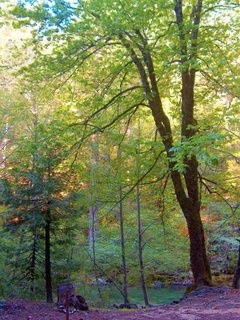 Bigleaf maple (Acer macrophyllum) on the Feather River Little North Fork, north of Strawberry Valley. Photo by queerbychoice. (See the Conifers, Oaks, and Native Edible Fruits pages for more information about some of these species.)
Bigleaf maple (Acer macrophyllum) on the Feather River Little North Fork, north of Strawberry Valley. Photo by queerbychoice. (See the Conifers, Oaks, and Native Edible Fruits pages for more information about some of these species.)
bigleaf maple california buckeye Pacific madrone sticky whiteleaf manzanita MacNab's cypress incense cedar (also called white cedar, post cedar, or bastard cedar) birchleaf mountain mahogany tanoak foothill pine (also called gray pine, pinon pine, or bull pine) bitter cherry canyon live oak (also called goldcup oak or maul oak) Leather oak* California black oak California bay laurel (also called Oregon myrtle)
*found exclusively on serpentine soils
 Pacific madrone (Arbutus menziesii) in the California State University Sacramento arboretum. Photo by queerbychoice.
Pacific madrone (Arbutus menziesii) in the California State University Sacramento arboretum. Photo by queerbychoice. 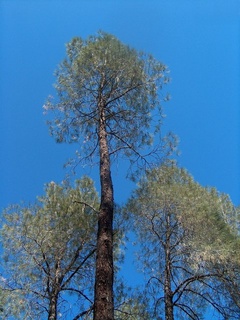 Gray pine (Pinus sabiniana) in Hammon Grove Park. Photo by queerbychoice.
Gray pine (Pinus sabiniana) in Hammon Grove Park. Photo by queerbychoice.  Canyon live oak (Quercus chrysolepis). Photo by queerbychoice.
Canyon live oak (Quercus chrysolepis). Photo by queerbychoice.  California black oak (Quercus kelloggii) can be identified by the bristles on the tips of its large, deeply lobed leaves. Photo by queerbychoice.
California black oak (Quercus kelloggii) can be identified by the bristles on the tips of its large, deeply lobed leaves. Photo by queerbychoice.  California bay laurel (Umbellularia californica). Photo by queerbychoice.
California bay laurel (Umbellularia californica). Photo by queerbychoice.
Shrubs
 A red-twig dogwood (Cornus sericea) shows off its fall colors in a Marysville garden. Photo by queerbychoice. (See the California Lilacs, Buckthorns, Monkeyflowers, and Roses pages for more information about some of these species.)
A red-twig dogwood (Cornus sericea) shows off its fall colors in a Marysville garden. Photo by queerbychoice. (See the California Lilacs, Buckthorns, Monkeyflowers, and Roses pages for more information about some of these species.)
red-twig dogwood (also called red osier dogwood or American creek dogwood) bush poppy yerba santa California coffeeberry toyon (also called Christmas berry) cream bush sticky monkeyflower ninebark dwarf wood rose ground rose
 A California coffeeberry (Frangula californica) in the American River Parkway, laden with fruit. Photo by queerbychoice.
A California coffeeberry (Frangula californica) in the American River Parkway, laden with fruit. Photo by queerbychoice. 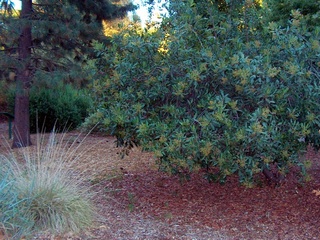 Toyon (Heteromeles arbutifolia) in the California State University Sacramento arboretum. The clusters of berries will turn bright red as they ripen. Photo by queerbychoice.
Toyon (Heteromeles arbutifolia) in the California State University Sacramento arboretum. The clusters of berries will turn bright red as they ripen. Photo by queerbychoice. 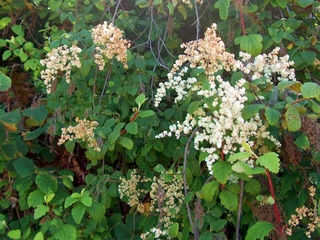 Ocean spray (Holodiscus discolor). Photo by queerbychoice.
Ocean spray (Holodiscus discolor). Photo by queerbychoice.  Red-flowering form of bush monkeyflower (Mimulus aurantiacus) in a garden in Marysville. Photo by queerbychoice.
Red-flowering form of bush monkeyflower (Mimulus aurantiacus) in a garden in Marysville. Photo by queerbychoice. 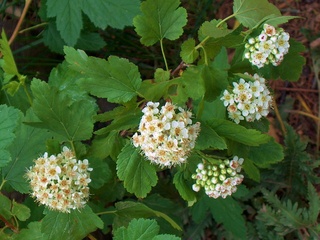 Pacific ninebark (Physocarpus capitatus) blooms in a garden in Marysville. Photo by queerbychoice.
Pacific ninebark (Physocarpus capitatus) blooms in a garden in Marysville. Photo by queerbychoice. 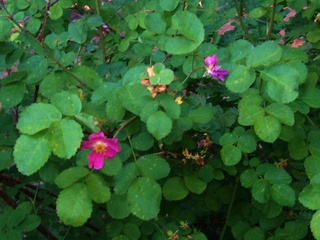 Dwarf wood rose (Rosa gymnocarpa) near Quincy. Photo by queerbychoice.
Dwarf wood rose (Rosa gymnocarpa) near Quincy. Photo by queerbychoice.
Perennial Herbs
Monocots
Grasses and Grasslike Plants
 California oniongrass (Melica californica) in a garden in Marysville. Photo by queerbychoice. (See the Ryegrasses, Oniongrasses, and Sedges pages for more information about some of these species.)
California oniongrass (Melica californica) in a garden in Marysville. Photo by queerbychoice. (See the Ryegrasses, Oniongrasses, and Sedges pages for more information about some of these species.)
Stillman's needlegrass woodland brome (also called Chinook brome or narrowflower brome) Brainerd's sedge blue wildrye meadow barley California melic Geyer's oniongrass
Bulbs and Corms
Asparagus Family
(See the Cluster-Lilies page for more information about these and other cluster-lily species.)
California cluster-lily Sierra brodiaea Bridges' brodiaea
Lily Family
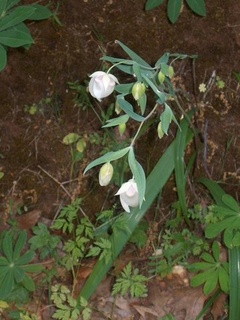 Fairy Lantern (Calochortus albus). Photo by queerbychoice. (See the Tulips and Fritillaries pages for more information about some of these species.)
Fairy Lantern (Calochortus albus). Photo by queerbychoice. (See the Tulips and Fritillaries pages for more information about some of these species.)
fairy lantern (also called white globe lily) blue star tulip naked mariposa tulip Sierra fawnlily (also called adderstongue) checker lily chocolate lily Butte County fritillary scarlet fritillary fragrant fritillary panther lily
 Naked mariposa tulip (Calochortus nudus) near Quincy. This flower is named for its relative lack of the hairs at the inner base of the petals that are more numerous in other members of the genus Calochortus. Photo by queerbychoice.
Naked mariposa tulip (Calochortus nudus) near Quincy. This flower is named for its relative lack of the hairs at the inner base of the petals that are more numerous in other members of the genus Calochortus. Photo by queerbychoice.
Onion Family
 Narrowleaf onion (Allium amplectens) blooms on Table Mountain. Photo by queerbychoice. (See the Onions page for more information about these and other onion species.)
Narrowleaf onion (Allium amplectens) blooms on Table Mountain. Photo by queerbychoice. (See the Onions page for more information about these and other onion species.)
narrowleaf onion papery onion Sanborn's onion
Other Bulbs and Corms
 Hartweg's doll's lily (Odontostomum hartwegii) blooms in a garden in Marysville. Photo by queerbychoice. clustered lady's slipper longtube iris (also called bowltube iris or ground iris) Hartweg's doll's lily
Hartweg's doll's lily (Odontostomum hartwegii) blooms in a garden in Marysville. Photo by queerbychoice. clustered lady's slipper longtube iris (also called bowltube iris or ground iris) Hartweg's doll's lily
Dicots
Aster Family
 The large yellow flowers and spiky, gum-filled buds of hairy gumplant (Grindelia hirsutula) mingle with the pink flowers of mountain garland and the smaller yellow flowers of California buttercup in a garden in Marysville. Photo by queerbychoice. (See the Daisies and Mule Ears pages for more information about some of these species.)
The large yellow flowers and spiky, gum-filled buds of hairy gumplant (Grindelia hirsutula) mingle with the pink flowers of mountain garland and the smaller yellow flowers of California buttercup in a garden in Marysville. Photo by queerbychoice. (See the Daisies and Mule Ears pages for more information about some of these species.)
lesser California rayless fleabane California everlasting (also called California cudweed) hairy gumplant Bolander's mule ears
 Bolander's mule ears (Wyethia bolanderi) flowers bend to face the ground on a steep slope. Photo by queerbychoice.
Bolander's mule ears (Wyethia bolanderi) flowers bend to face the ground on a steep slope. Photo by queerbychoice.
Carrot Family
Mother Lode yampah snakeroot (also called purple sanicle) Hartweg's umbrellawort
Mint Family
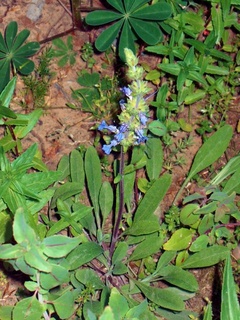 Creeping sage (Salvia sonomensis) in a garden in Marysville. Photo by queerbychoice. (See the Coyote Mints page for more information about some of these species.)
Creeping sage (Salvia sonomensis) in a garden in Marysville. Photo by queerbychoice. (See the Coyote Mints page for more information about some of these species.)
Shelton's coyote mint coyote mint Sonoma sage (also called creeping sage)
Other Families
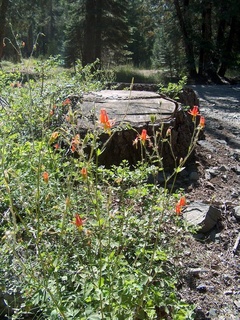 Western columbine (Aquilegia formosa) at Bowman Lake in Nevada County. Photo by queerbychoice. (See the Milkweeds, Paintbrushes, Willowherbs, and Buttercups pages for more information about some of these species.)
Western columbine (Aquilegia formosa) at Bowman Lake in Nevada County. Photo by queerbychoice. (See the Milkweeds, Paintbrushes, Willowherbs, and Buttercups pages for more information about some of these species.)
Western columbine California spikenard (also called elk's clover) purple milkweed purplish morning glory Frosted paintbrush padre's shooting star California fuchsia sun rose seep monkeyflower (also called common yellow monkeyflower) largeleaf sandwort Sierra milkwort whitevein wintergreen (also called whitevein shinleaf) California buttercup (also called common buttercup) checker mallow
 California fuchsia (Epilobium canum) blooms in a garden in Marysville. Photo by queerbychoice.
California fuchsia (Epilobium canum) blooms in a garden in Marysville. Photo by queerbychoice.  Whitevein wintergreen (Pyrola picta) near Quincy. Photo by queerbychoice.
Whitevein wintergreen (Pyrola picta) near Quincy. Photo by queerbychoice.  A California buttercup (Ranunculus californicus) blooming in a Marysville garden. Photo by queerbychoice.
A California buttercup (Ranunculus californicus) blooming in a Marysville garden. Photo by queerbychoice.  Checker mallow (Sidalcea malviflora) in a garden in Marysville. Photo by queerbychoice.
Checker mallow (Sidalcea malviflora) in a garden in Marysville. Photo by queerbychoice.
Ferns
 Five-finger fern (Adiantum aleuticum) in a Marysville garden. Photo by queerbychoice. (See the Horsetails and Maidenhair Ferns pages for more information about these and other fern and horsetail species.)
Five-finger fern (Adiantum aleuticum) in a Marysville garden. Photo by queerbychoice. (See the Horsetails and Maidenhair Ferns pages for more information about these and other fern and horsetail species.)
five-finger fern (also called Western maidenhair fern) scouringrush horsetail California polypody Western brackenfern
 Scouring rush horsetail (Equisetum hyemale) in Beckwourth Riverfront Park Complex. Photo by queerbychoice.
Scouring rush horsetail (Equisetum hyemale) in Beckwourth Riverfront Park Complex. Photo by queerbychoice.  California polypody (Polypodium californicum) in a Marysville garden, with California poppy seedlings in the background. Photo by queerbychoice.
California polypody (Polypodium californicum) in a Marysville garden, with California poppy seedlings in the background. Photo by queerbychoice.
Annuals
Aster Family
(See the Tarweeds and Tidytips pages for more information about these and other tarweed and tidytip species.)
sticky Western rosinweed truncated Western rosinweed Colusa tidytips meager tarweed (also called small tarweed or little tarweed)
Other Families
 The tiny, pale pink flowers of miner's lettuce (Claytonia perfoliata) bloom in a garden in Marysville. This plant is prized as a salad ingredient, generally sold only at high-end grocery stores. Growing your own is much cheaper than buying it from a grocery store! Photo by queerbychoice. (See the Bentgrasses, Willowherbs, Buckwheats, Monkeyflowers, and Clovers pages for more information about some of these species.)
The tiny, pale pink flowers of miner's lettuce (Claytonia perfoliata) bloom in a garden in Marysville. This plant is prized as a salad ingredient, generally sold only at high-end grocery stores. Growing your own is much cheaper than buying it from a grocery store! Photo by queerbychoice. (See the Bentgrasses, Willowherbs, Buckwheats, Monkeyflowers, and Clovers pages for more information about some of these species.)
littleleaf bentgrass miner's lettuce little chaparral willowherb wickerstem buckwheat Sierra bluecup brownies (also called purple mouse ears) California sandwort downy pincushionplant (also called purple pincushionplant) dotseed plantain (also called foothill plantain or California plantain) Sierra mock stonecrop valley checker mallow sour clover (also called bull clover) hairy maiden clover (also called smallhead field clover) tomcat clover
 Sour clover (Trifolium fucatum) blooms in a garden in Marysville. Photo by queerbychoice.
Sour clover (Trifolium fucatum) blooms in a garden in Marysville. Photo by queerbychoice. 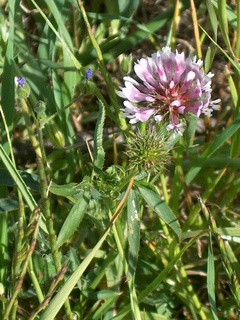 Tomcat clover (Trifolium willdenovii) in flower and bud on Table Mountain. Photo by queerbychoice.
Tomcat clover (Trifolium willdenovii) in flower and bud on Table Mountain. Photo by queerbychoice.
Footnotes
1. CalFlora.org


